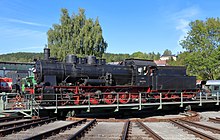FAUR
 | |
| Company type | Public:(BVB:FAU) |
|---|---|
| Industry | Railroad Power Generation |
| Predecessor | MALAXA 23 August Works |
| Founded | 1921 |
| Founder | Nicolae Malaxa |
| Headquarters | Bucharest,Romania |
| Products | Locomotives Diesel engines OEM parts |
| Services | Locomotive maintenance Locomotive management Training |
| Parent | Bega Group |
| Website | faur.ro |
FAUR S.A.is an industrial engineering and manufacturing company based inBucharest,Romania.
History
[edit]FAUR was founded byNicolae Malaxain 1921 under the nameMALAXA.Main activities were the repairing of rolling stock, manufacturingsteam locomotives,diesel locomotives,car-engines and passenger coaches, diesel engines, brake equipment, and special alloy steels. By the end of the 1930s, the Malaxa factories were one of the biggest industrial group in Southeastern Europe, and the main provider of equipment for theRomanian Railwaysduring the period.[citation needed]
Nationalisedin 1948, part of the company became known as23 August Works,referring to the1944 Romanian coup d'état.DuringCommunist Romaniait extended its range of manufacturing by approaching pilot projects to the most Romanian industries but also to other countries in Europe, Asia and Africa.
From 1976 to 1985, 200DR Class 119engines were built forDeutsche Reichsbahn (East Germany),as a result of the 1970sComecon(Council for Mutual Economic Assistance) agreements. TheEast Germaneconomy was not allowed anymore to build diesel locomotives with more than 1,500 horsepower, and the locomotive builders of the Soviet Union could only supply engines that were too heavy for some lines in East Germany, limited to an axle load (Achsfahrmasse) of under 16 t. Yet, a power output of over 2,000 horsepower was needed. LiterallyDesign by committee,the 119 was built in Romania according to a "construction kit" (Baukasten) principle. East German diesel engines should have been used, but due to coordination problems in East Germany's national planning commission, the Bucharest factory installed engines under licence from theWest Germanmanufacturer,MTU.Other countries in Comecon also received subcontractor orders. East Germany itself suppliedinter aliahydrodynamic transmissionsand axle motors. The locomotive drive was, however, plagued by shortcomings and problems from the start. In its early days, 50% of the locomotives were in the workshops at any one time. As a result, only 200 engines were built, not 250 or more as intended.
In 1990, the company was renamed FAUR and privatized.
Since 2004, FAUR is part ofBega Group.[1]
Steam locomotives
[edit]
Since 1920, the design and the construction of different types ofrailway enginesbegan at the Domains Factories (nowadaysUMC Reșița) inReșițaand Malaxa Factories in Bucharest. Due to the success of the construction of the railway engines in Reșița and Bucharest factories, Romania ceased importing railway locomotives starting with 1930. Between 1926 and 1960, a total number of 1,207steam locomotiveswere built in Romania: 10 models forstandard tracksand 3 models for thenarrow gauge railways.From these, 797 steam locomotives were made in Reșița Factories and 410 at Malaxa Factories. In 1960 the production of steam locomotives was ceased, the Romanian industry focusing on fabrication of the diesel railway engines.[2]
Diesel-electric and diesel-hydraulic locomotives
[edit]
See also
[edit]- Malaxa car
- Căile Ferate Române,Romanian Railways
- Mareșal tank destroyer
- Renault UE Chenillette
References
[edit]- ^Brief History
- ^"The first railway engines in Romania".Archived fromthe originalon 19 March 2012.Retrieved3 December2011.
External links
[edit]- Official website(in English)
- Clippings about FAURin the20th Century Press Archivesof theZBW
- Locomotive manufacturers of Romania
- Companies based in Bucharest
- Manufacturing companies established in 1921
- Romanian brands
- Rolling stock manufacturers of Romania
- Privatized companies in Romania
- Companies listed on the Bucharest Stock Exchange
- Greater Romania
- 1921 establishments in Romania
- Manufacturing company stubs
- Romania stubs
